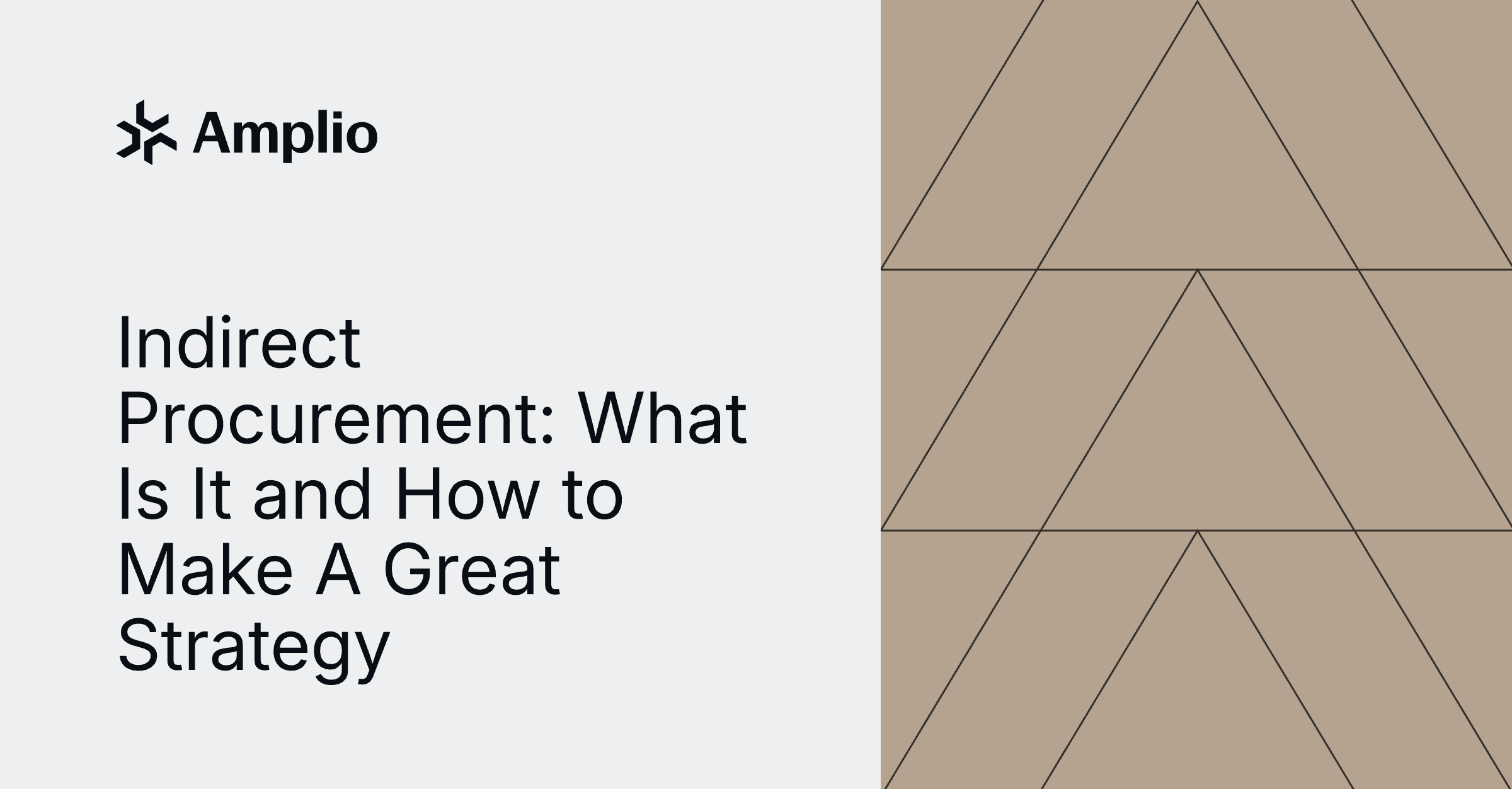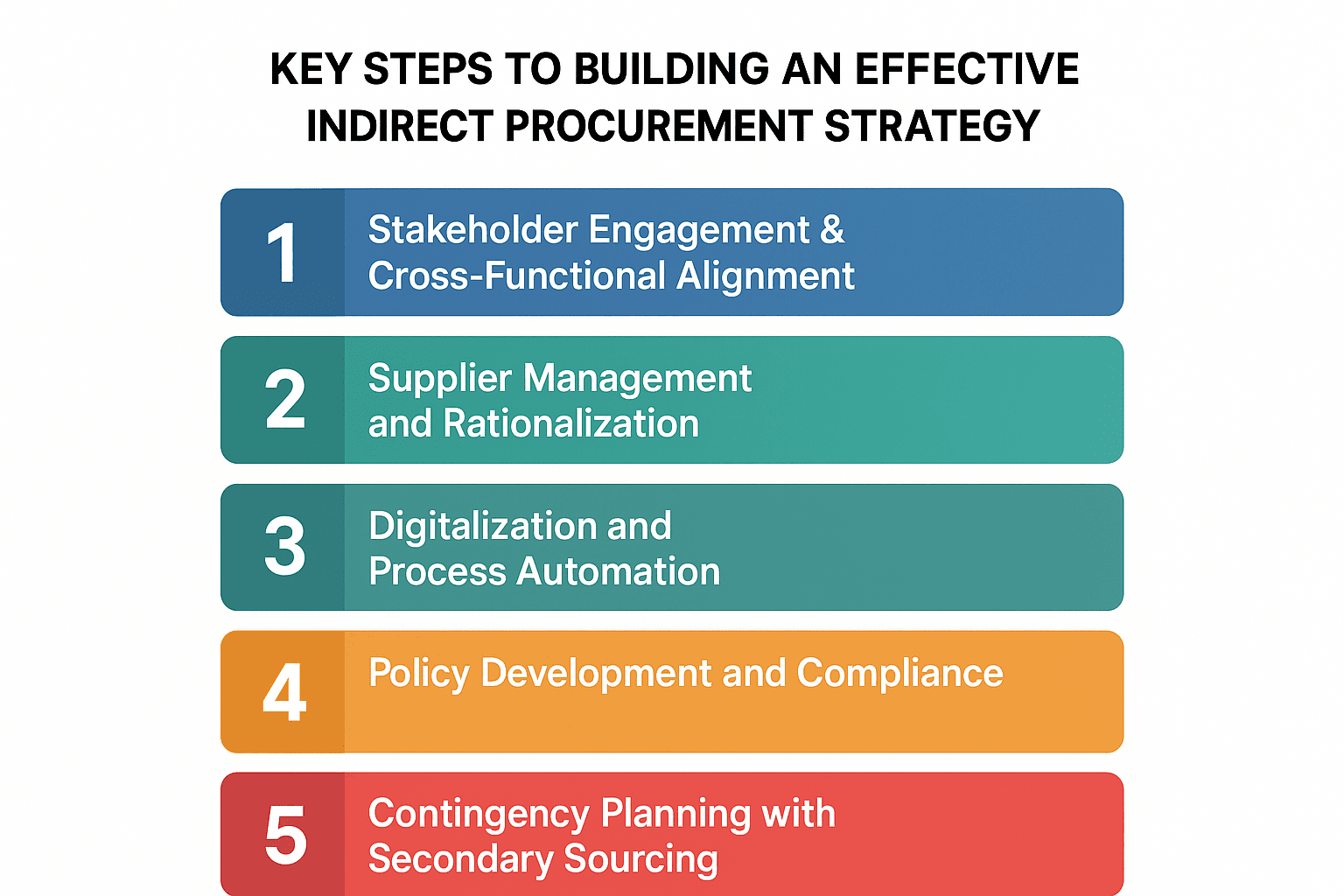Indirect Procurement: What Is It and How to Make A Great Strategy

Indirect procurement rarely makes headlines, yet it’s a critical lever that shapes your organization’s cost base and operational efficiency.
For enterprise manufacturers and industrial buyers, a strong indirect procurement strategy is essential for controlling spend, reducing supply risk, and supporting compliance.
In this blog, you’ll learn what indirect procurement is, why it matters, and the steps required to build a high-impact, resilient strategy for your business.
What Is Indirect Procurement?

Indirect procurement refers to the sourcing of goods and services that support your business operations but do not directly enter into your finished products.
The purchases through indirect procurement may seem peripheral, but they account for a significant share of operational spend and have a direct impact on cost control, efficiency, and business resilience.
Indirect procurement is often more complex to manage due to the variety of categories, fragmented spend across departments, and frequent use of one-off suppliers. For manufacturers and industrial businesses, mastering indirect procurement means gaining control over hidden costs and supporting sustainable growth.
Categories of Goods and Services in Indirect Procurement
Indirect procurement covers a broad spectrum of goods and services essential to daily operations but not incorporated into your final product. The categories below represent the primary areas of indirect procurement:
a) Goods Commonly Purchased Through Indirect Procurement
- MRO Supplies: Maintenance, repair, and operations (MRO) items—such as spare parts, tools, lubricants, cleaning products, and safety gear.
- Electronics: Office computers, monitors, networking equipment, mobile devices, and peripherals needed for daily business operations.
- Office Supplies & Equipment: Furniture, printers, stationery, and general office consumables.
- Facility and Building Management: Lighting, HVAC systems, security equipment, and janitorial supplies.
b) Services Commonly Procured through Indirect Procurement
- IT and Telecom Services: Software licenses, cloud computing, technical support, telecommunications, and network infrastructure.
- Professional and Consulting Services: Legal, HR, training, and external project management.
- Facility Services: Cleaning, landscaping, catering, and maintenance.
- Logistics and Transportation: Freight, warehousing, courier, and delivery services.
Key Steps to Building an Effective Indirect Procurement Strategy

A high-performing indirect procurement strategy requires more than basic purchasing. With a disciplined, structured approach, you control spend, increase compliance, and drive measurable value across your supplier base. The following steps form the foundation of an effective indirect procurement program.
1. Stakeholder Engagement & Cross-Functional Alignment
Start by engaging key internal stakeholders from the outset—including finance, operations, IT, and facility management. Understand their unique needs and pain points to shape your sourcing priorities.
Align procurement objectives with broader business goals to ensure buy-in, minimize resistance, and drive long-term results. Regular communication and collaboration build trust and streamline decision-making throughout the procurement process.
2. Supplier Management and Rationalization
Next, review your supplier base for consolidation and risk exposure. Assess performance, reliability, and adherence to your procurement standards. A leaner, higher-quality supplier roster strengthens your negotiating power, lowers admin costs, and raises service levels across the board.
Develop clear, consistent criteria for supplier selection, focusing on factors such as quality, cost competitiveness, responsiveness, and alignment with your business goals. Regularly assess supplier risks—including financial stability and geographic exposure—to ensure your procurement process remains resilient and efficient.
3. Digitalization and Process Automation
As your procurement strategy matures, embracing digital tools becomes essential for efficiency and visibility. Implement e-procurement platforms to centralize purchasing, streamline supplier management, and automate approval workflows. These solutions reduce manual effort, eliminate paperwork, and provide real-time tracking of spend and contract compliance.
Automate processes to accelerate procurement cycles and to deliver actionable data for continuous improvement. With greater transparency and fewer bottlenecks, your team can focus on strategic initiatives that add measurable value to your indirect procurement program.
4. Policy Development and Compliance
Establishing clear procurement policies and approval matrices is critical for maintaining control over indirect spend.
Develop standardized guidelines that define purchasing procedures, authorization limits, and supplier engagement protocols. Clear policies help improve procurement efficiency, reduce maverick spending, and ensure consistency across your organization.
Continuously monitor compliance with these policies through regular audits and system controls. Address unauthorized purchases promptly to maintain spend discipline and minimize risk. Robust policy enforcement is the backbone of a scalable, compliant indirect procurement function.
5. Contingency Planning with Secondary Sourcing
Mitigating risk in indirect procurement means planning for disruptions before they occur. Develop a contingency procurement strategy by establishing relationships with secondary suppliers for critical indirect categories. This proactive approach protects your operations against supply interruptions, vendor failures, and unexpected market changes.
A robust secondary supply chain ensures business continuity and shields your organization from the costly delays that can result from relying on a single source. Regularly review and update your contingency plans to reflect changing market conditions and evolving business needs.
Strategic Channels To Use for Indirect Procurement of Goods

Selecting the right channels is essential for effective indirect procurement. Here are strategic channels that I think you can activate for indirect procurement of goods:
a) Direct Supplier Relationships With OEMs
Start by negotiating contracts directly with original equipment manufacturers (OEMs). It gives you greater control over quality, pricing, and delivery terms. This channel is ideal for critical categories where performance, compliance, and service levels are non-negotiable.
b) Group Purchasing Organizations (GPOs)
Group Purchasing Organizations (GPOs) combine the buying power of multiple businesses to secure lower prices and better terms from suppliers. Joining a GPO lets you access discounted rates on MRO supplies, office equipment, and facility services—even if your order volume is small. This delivers immediate cost savings without requiring high minimums or complex negotiations.
c) Auctions
Auctions also offer a dynamic channel for sourcing indirect goods, especially when you’re seeking cost-saving opportunities or need to address urgent requirements. Through industrial auction platforms, you can acquire surplus, refurbished, or discontinued inventory at competitive prices. Auctions are particularly effective for one-time purchases or hard-to-find items, enabling you to respond quickly to immediate operational needs while keeping costs in check.
d) Industrial Liquidators
Industrial liquidators can connect your indirect procurement team with a vetted network of sellers offering surplus equipment, spare parts, and MRO inventory. By working with experienced liquidators, you gain access to quality assets at discounted rates, often with faster turnaround than traditional procurement channels. This approach not only streamlines sourcing for hard-to-find or urgent needs but also supports your organization’s circular procurement and sustainable procurement goals, keeping valuable resources in use and reducing waste across the supply chain.
How Amplio Helps You in Indirect Procurement

Access to Vetted Supplier Networks and Negotiation Support
Amplio connects you directly with a network of trusted, pre-qualified industrial sellers. Our AI part-matching tools read your PO and can identify exact and similar matches to get you hard-to-find parts in a hurry.
Our team assists you throughout the negotiation process to help secure the right value and terms for your business.
Frictionless Buying Experience
With Amplio, the entire purchasing process is streamlined from start to finish. Our dedicated support team handles communications and logistics, reducing delays and complexity in every transaction.
Enhanced Catalogs and Search Tools
Amplio’s AI cataloging assistant improves item descriptions and clarifies technical details, making it easier to evaluate large-scale enterprise liquidations. Use targeted filters and comprehensive image galleries to find exactly what your operation needs, without sorting through messy lists.
Powerful Product Discovery
Amplio’s intuitive platform features advanced search tools so you can quickly filter inventory by category, specifications, and condition, supported by detailed images and user reviews. This gives you the clarity and speed needed to make confident, well-informed procurement decisions.
Get started with Amplio to optimize your indirect procurement strategy and capture measurable value for your business.